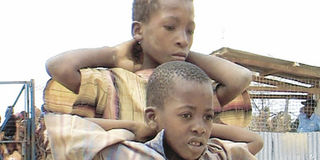Field for dumping the dead now hosting hungry refugees

Two children displaced by renewed hostilities in Somalia, inside the compound of United Nations High Commissioner for Refugees offices in Dadaab. Photo/FILE
It is known as Bula baqti, Somali for the place of the carcass.
Until a year and half ago, refugees in Dagahaley Camp in Dadaab dumped their dead relatives as well as livestock in the field. Not any more.
It is now teeming with 22,000 Somali refugees crossing the border to Kenya from the ravaging drought and insecurity in their country.
The dump site has become a refuge for thousands fleeing the twin catastrophes, but who cannot get a place in the designated camps that are already full.
The other alternative would have been Ifo II, but the controversy over the new camp persists as the government appears to be going back on its word.
Prime Minister
On Thursday last week, Prime Minister Raila Odinga said the Ifo II Camp, which can fit up to 80,000 people, would open within 10 days after initial reluctance, citing security reasons. But five days later, the UN agency for refugees, UNHCR, said they have been receiving conflicting directives from the provincial administration.
“The Prime Minister has said that the camp should be opened, but we have realities on the ground we have to manage. The Provincial Commissioner’s letter suspending the construction of the camp still stands over us,” said Fafa Olivier Attidzah, the head of the UNHCR staff office in Dadaab.
Bula baqti is a non-designated area in the outskirts of the Dagahaley Refugee Camp which has now been fully occupied by the fleeing Somali nationals.
“Not so long ago, refugees would take their dead to Bula baqti which largely lay bare, but things have changed,” Sorayia Musau, an aid worker with the Lutheran World Federation told the Nation. “But now they are settling there for lack of an alternative,” she added.
Mohamed Mursal of the Save the Children Kenya programme adds that the refugees dumped their dead there because they had no alternative site in the camp.
“All the dead in the old Dagahaley Camp would be deposited in the field and that is why it is called Bula baqti that means the place of carcasses,” Mursal narrated.
Crossing daily
Here in Bula baqti is where Sangabo Mohamud, a mother of seven, now calls home. She arrived at the Dagaheley reception site four months ago. Then, the Dagaheley Camp was already full, with the estimated 1,300 refugees crossing the border to Kenya daily according to aid agencies in Dadaab.
As if that was not enough, the Ifo II Camp still remains out of bounds under the directive of the Kenya government. Left with no alternative, Mohamud took her rations and proceeded to settle at Bula baqti.
She has no plans of going back to Somalia; neither is the name “the place of carcass” a bother to her. She has arrived in the “Promised Land” where there is food, water and security.
She shares the hut with her family of seven children, while her husband is still admitted in hospital run by one of the aid agencies.
“We have nowhere else to live except here,” she says. And when asked by visiting Dutch minister for Development cooperation Dr Ben Knapen whether the children were going to school, she responded, “We are not giving education priority. We want to get food first.”
Also in the camp is Abshiro Isaack, a mother of four-month-old twins, Rahma and Zahra. She’s only days old in Bula baqti and still shows the scars of her long trek from Somalia.
The Nation met her at the Dagahaley reception site where she had gone to receive her rations. Weak from hunger and the long trek, she hardly has the energy to walk around with the twins, or breast feed them. She thus decided to leave Zahra with her aunt at their new home as she went in search of food.
Dr Knapen called on the government to expand the camps for refugees to accommodate the rising numbers.
As a result of the conflicting government positions on the opening of the Ifo II Camp, the UNHCR says 35,000 refugees are living in undesignated areas around the camps, including on a riverbed of a seasonal river that has dried up because of the drought.
Dr Knapen who visited the various camps including the Ifo II and those outside the designated areas pushed for the refugees to occupy the Ifo II Camp.
“I would very much would like to know what is going to happen with this Ifo II Camp because it looks beautiful, houses and all facilities are there and no one uses it, which is a pity,” the visiting Dutch minister said.
“I do understand that there are some security concerns and also that the people around the camps are a little bit reluctant to take more refugees.
“Having said that, the government built this camp last year and we as Dutch government also invested in this camp. We would very much appreciate if the camp could be used,” Dr Knapen added.




